Progress and Challenges in Quantifying Carbonyl-Metabolomic Phenomes with LC-MS/MS
Abstract
:1. Introduction
2. Types of Derivatization Reagents for Carbonyl-Containing Metabolites
2.1. Hydrazines
2.2. Hydrazides
2.3. Hydroxylamines
2.4. Amines
2.5. Others
3. Application of the Stable Isotope-Coded Derivatization Method in LC-MS Analysis of Carbonyl-Containing Metabolites
3.1. Absolute Quantification
3.2. Submetabolome Profiling
4. Conclusions
Supplementary Materials
Author Contributions
Funding
Conflicts of Interest
References
- Uchida, K. Role of reactive aldehyde in cardiovascular diseases. Free Radic. Biol. Med. 2000, 28, 1685–1696. [Google Scholar] [CrossRef]
- Del Rio, D.; Stewart, A.J.; Pellegrini, N. A review of recent studies on malondialdehyde as toxic molecule and biological marker of oxidative stress. Nutr. Metab. Cardiovasc. Dis. 2005, 15, 316–328. [Google Scholar] [CrossRef]
- Domingues, R.M.; Domingues, P.; Melo, T.; Perez-Sala, D.; Reis, A.; Spickett, C.M. Lipoxidation adducts with peptides and proteins: Deleterious modifications or signaling mechanisms? J. Proteom. 2013, 92, 110–131. [Google Scholar] [CrossRef]
- Fedorova, M.; Bollineni, R.C.; Hoffmann, R. Protein Carbonylation as a Major Hallmark of Oxidative Damage: Update of Analytical Strategies. Mass Spectrom. Rev. 2014, 33, 79–97. [Google Scholar] [CrossRef] [PubMed]
- Holst, J.P.; Soldin, O.P.; Guo, T.D.; Soldin, S.J. Steroid hormones: Relevance and measurement in the clinical laboratory. Clin. Lab. Med. 2004, 24, 105–118. [Google Scholar] [CrossRef] [PubMed] [Green Version]
- Holst, J.P.; Soldin, S.J.; Tractenberg, R.E.; Guo, T.D.; Kundra, P.; Verbalis, J.G.; Jonklaas, J. Use of steroid profiles in determining the cause of adrenal insufficiency. Steroids 2007, 72, 71–84. [Google Scholar] [CrossRef] [Green Version]
- Santen, R.J.; Yue, W.; Wang, J.-P. Estrogen metabolites and breast cancer. Steroids 2015, 99, 61–66. [Google Scholar] [CrossRef]
- Eisenhofer, G.; Dekkers, T.; Peitzsch, M.; Dietz, A.S.; Bidlingmaier, M.; Treitl, M.; Williams, T.A.; Bornstein, S.R.; Haase, M.; Rump, L.C.; et al. Mass Spectrometry-Based Adrenal and Peripheral Venous Steroid Profiling for Subtyping Primary Aldosteronism. Clin. Chem. 2016, 62, 514–524. [Google Scholar] [CrossRef] [PubMed] [Green Version]
- Qu, M.; Ma, S.; Huang, Y.; Yuan, H.; Zhao, Y. LC-MS/MS-based non-isotopically paired labeling (NIPL) Strategy for the qualification and quantification of monosaccharides. Talanta 2021, 231, 122336. [Google Scholar] [CrossRef] [PubMed]
- Pavlova, N.N.; Thompson, C.B. The Emerging Hallmarks of Cancer Metabolism. Cell Metab. 2016, 23, 27–47. [Google Scholar] [CrossRef] [Green Version]
- Perluigi, M.; Coccia, R.; Butterfield, D.A. 4-Hydroxy-2-Nonenal, a Reactive Product of Lipid Peroxidation, and Neurodegenerative Diseases: A Toxic Combination Illuminated by Redox Proteomics Studies. Antioxid. Redox Signal. 2012, 17, 1590–1609. [Google Scholar] [CrossRef] [PubMed] [Green Version]
- Sas, K.M.; Karnovsky, A.; Michailidis, G.; Pennathur, S. Metabolomics and Diabetes: Analytical and Computational Approaches. Diabetes 2015, 64, 718–732. [Google Scholar] [CrossRef] [Green Version]
- Wu, D.M.; Zhang, J.J.; Guo, N.; Zheng, S.J.; Zhu, Q.F.; Feng, Y.Q.; Peng, S.S.; Wu, Y.H.; Tuo, M.H. Cognitive impairment correlates with serum carbonyl compound profiles in subclinical carotid atherosclerosis. Neuroreport 2018, 29, 1550–1557. [Google Scholar] [CrossRef] [PubMed]
- Lovell, M.A.; Xie, C.S.; Markesbery, W.R. Acrolein is increased in Alzheimer’s disease brain and is toxic to primary hippocampal cultures. Neurobiol. Aging 2001, 22, 187–194. [Google Scholar] [CrossRef]
- Poli, D.; Goldoni, M.; Corradi, M.; Acampa, O.; Carbognani, P.; Internullo, E.; Casalini, A.; Mutti, A. Determination of aldehydes in exhaled breath of patients with lung cancer by means of on-fiber-derivatisation SPME-GC/MS. J. Chromatogr. B 2010, 878, 2643–2651. [Google Scholar] [CrossRef] [PubMed]
- Vanholder, R.; De Smet, R.; Glorieux, G.; Argiles, A.; Baurmeister, U.; Brunet, P.; Clark, W.; Cohen, G.; De Deyn, P.P.; Deppisch, R.; et al. Review on uremic toxins: Classification, concentration, and interindividual variability. Kidney Int. 2003, 63, 1934–1943. [Google Scholar] [CrossRef] [PubMed] [Green Version]
- Kancheva, L.; Hill, M.; Vcelakova, H.; Vrbikova, J.; Pelikanova, T.; Starka, L. The identification and simultaneous quantification of neuroactive androstane steroids and their polar conjugates in the serum of adult men, using gas chromatography-mass spectrometry. Steroids 2007, 72, 792–801. [Google Scholar] [CrossRef]
- Kushnir, M.M.; Rockwood, A.L.; Roberts, W.L.; Pattison, E.G.; Bunker, A.M.; Fitzgerald, R.L.; Meikle, A.W. Performance characteristics of a novel tandem mass spectrometry assay for serum testosterone. Clin. Chem. 2006, 52, 120–128. [Google Scholar] [CrossRef] [PubMed]
- Han, W.; Li, L. Matrix effect on chemical isotope labeling and its implication in metabolomic sample preparation for quantitative metabolomics. Metabolomics 2015, 11, 1733–1742. [Google Scholar] [CrossRef]
- Sun, M.; Manolopoulou, J.; Spyroglou, A.; Beuschlein, F.; Hantel, C.; Wu, Z.D.; Bielohuby, M.; Hoeflich, A.; Liu, C.; Bidlingmaier, M. A microsphere-based duplex competitive immunoassay for the simultaneous measurements of aldosterone and testosterone in small sample volumes: Validation in human and mouse plasma. Steroids 2010, 75, 1089–1096. [Google Scholar] [CrossRef]
- Ohlsson, C.; Nilsson, M.E.; Tivesten, A.; Ryberg, H.; Mellstrom, D.; Karlsson, M.K.; Ljunggren, O.; Labrie, F.; Orwoll, E.S.; Lee, D.M.; et al. Comparisons of Immunoassay and Mass Spectrometry Measurements of Serum Estradiol Levels and Their Influence on Clinical Association Studies in Men. J. Clin. Endocrinol. Metab. 2013, 98, E1097–E1102. [Google Scholar] [CrossRef] [Green Version]
- Kushnir, M.M.; Blamires, T.; Rockwood, A.L.; Roberts, W.L.; Yue, B.F.; Erdogan, E.; Bunker, A.M.; Meikle, A.W. Liquid Chromatography-Tandem Mass Spectrometry Assay for Androstenedione, Dehydroepiandrosterone, and Testosterone with Pediatric and Adult Reference Intervals. Clin. Chem. 2010, 56, 1138–1147. [Google Scholar] [CrossRef] [Green Version]
- Fanelli, F.; Belluomo, I.; Di Lallo, V.D.; Cuomo, G.; De Iasio, R.; Baccini, M.; Casadio, E.; Casetta, B.; Vicennati, V.; Gambineri, A.; et al. Serum steroid profiling by isotopic dilution-liquid chromatography-mass spectrometry: Comparison with current immunoassays and reference intervals in healthy adults. Steroids 2011, 76, 244–253. [Google Scholar] [CrossRef] [Green Version]
- Nicholson, J.K.; Lindon, J.C. Systems biology—Metabonomics. Nature 2008, 455, 1054–1056. [Google Scholar] [CrossRef]
- Stringer, K.A.; McKay, R.T.; Karnovsky, A.; Quemerais, B.; Lacy, P. Metabolomics and its Application to Acute Lung Diseases. Front. Immunol. 2016, 7, 22. [Google Scholar] [CrossRef] [PubMed] [Green Version]
- Wishart, D.S. Advances in metabolite identification. Bioanalysis 2011, 3, 1769–1782. [Google Scholar] [CrossRef] [PubMed]
- Naz, S.; dos Santos, D.C.M.; Garcia, A.; Barbas, C. Analytical protocols based on LC-MS, GC-MS and CE-MS for nontargeted metabolomics of biological tissues. Bioanalysis 2014, 6, 1657–1677. [Google Scholar] [CrossRef]
- Gil, A.; Siegel, D.; Permentier, H.; Reijngoud, D.-J.; Dekker, F.; Bischoff, R. Stability of energy metabolitesAn often overlooked issue in metabolomics studies: A review. Electrophoresis 2015, 36, 2156–2169. [Google Scholar] [CrossRef] [PubMed]
- Gika, H.; Virgiliou, C.; Theodoridis, G.; Plumb, R.S.; Wilson, I.D. Untargeted LC/MS-based metabolic phenotyping (metabonomics/metabolomics): The state of the art. J. Chromatogr. B 2019, 1117, 136–147. [Google Scholar] [CrossRef] [PubMed]
- Rochat, B. From targeted quantification to untargeted metabolomics: Why LC-high-resolution-MS will become a key instrument in clinical labs. Trac-Trends Anal. Chem. 2016, 84, 151–164. [Google Scholar] [CrossRef]
- Yin, P.Y.; Xu, G.W. Current state-of-the-art of nontargeted metabolomics based on liquid chromatography-mass spectrometry with special emphasis in clinical applications. J. Chromatogr. A 2014, 1374, 1–13. [Google Scholar] [CrossRef]
- Gika, H.G.; Theodoridis, G.A.; Plumb, R.S.; Wilson, I.D. Current practice of liquid chromatography-mass spectrometry in metabolomics and metabonomics. J. Pharm. Biomed. Anal. 2014, 87, 12–25. [Google Scholar] [CrossRef]
- Santa, T. Derivatization reagents in liquid chromatography/electrospray ionization tandem mass spectrometry. Biomed. Chromatogr. 2011, 25, 1–10. [Google Scholar] [CrossRef] [PubMed]
- Jiang, R.Q.; Jiao, Y.; Xu, F.G. Chemical derivatization-based LC-MS for metabolomics: Advantages and challenges. Bioanalysis 2016, 8, 1881–1883. [Google Scholar] [CrossRef] [Green Version]
- Anderegg, R.J. Derivatization in mass spectrometry: Strategies for controlling fragmentation. Mass Spectrom. Rev. 1988, 7, 395–424. [Google Scholar] [CrossRef]
- Zhao, S.; Dawe, M.; Guo, K.; Li, L. Development of High-Performance Chemical Isotope Labeling LC-MS for Profiling the Carbonyl Submetabolome. Anal. Chem. 2017, 89, 6758–6765. [Google Scholar] [CrossRef] [PubMed] [Green Version]
- Guo, L.L.; Worth, A.J.; Mesaros, C.; Snyder, N.W.; Glickson, J.D.; Blair, I.A. Diisopropylethylamine/hexafluoroisopropanol-mediated ion-pairing ultra-high-performance liquid chromatography/mass spectrometry for phosphate and carboxylate metabolite analysis: Utility for studying cellular metabolism. Rapid Commun. Mass Spectrom. 2016, 30, 1835–1845. [Google Scholar] [CrossRef] [PubMed]
- Tudela, E.; Munoz, G.; Munoz-Guerra, J.A. Matrix effect marker for multianalyte analysis by LC-MS/MS in biological samples. J. Chromatogr. B 2012, 901, 98–106. [Google Scholar] [CrossRef]
- Higashi, T.; Ogawa, S. Isotope-coded ESI-enhancing derivatization reagents for differential analysis, quantification and profiling of metabolites in biological samples by LC/MS: A review. J. Pharm. Biomed. Anal. 2016, 130, 181–193. [Google Scholar] [CrossRef] [PubMed]
- Zhao, S.; Li, L. Chemical derivatization in LC-MS-based metabolomics study. Trac-Trends Anal. Chem. 2020, 131, 11. [Google Scholar] [CrossRef]
- Zhang, T.Y.; Li, S.; Zhu, Q.F.; Wang, Q.; Hussain, D.; Feng, Y.Q. Derivatization for liquid chromatography-electrospray ionization-mass spectrometry analysis of small-molecular weight compounds. Trac-Trends Anal. Chem. 2019, 119, 13. [Google Scholar] [CrossRef]
- Huang, T.J.; Armbruster, M.R.; Coulton, J.B.; Edwards, J.L. Chemical Tagging in Mass Spectrometry for Systems Biology. Anal. Chem. 2019, 91, 109–125. [Google Scholar] [CrossRef]
- El-Maghrabey, M.H.; Kishikawa, N.; Kuroda, N. Current trends in isotope-coded derivatization liquid chromatographic-mass spectrometric analyses with special emphasis on their biomedical application. Biomed. Chromatogr. 2020, 34, 29. [Google Scholar] [CrossRef] [PubMed]
- Zimmermann, M.; Sauer, U.; Zamboni, N. Quantification and Mass Isotopomer Profiling of alpha-Keto Acids in Central Carbon Metabolism. Anal. Chem. 2014, 86, 3232–3237. [Google Scholar] [CrossRef] [PubMed]
- Gowacki, R.; Stachniuk, J.; Borowczyk, K.; Jakubowski, H. Quantification of homocysteine and cysteine by derivatization with pyridoxal 5’-phosphate and hydrophilic interaction liquid chromatography. Anal. Bioanal. Chem. 2016, 408, 1935–1941. [Google Scholar] [CrossRef] [PubMed]
- Tang, Y.; Chu, J.M.; Huang, W.; Xiong, J.; Xing, X.W.; Zhou, X.; Feng, Y.Q.; Yuan, B.F. Hydrophilic Material for the Selective Enrichment of 5-Hydroxymethylcytosine and Its Liquid Chromatography-Tandem Mass Spectrometry Detection. Anal. Chem. 2013, 85, 6129–6135. [Google Scholar] [CrossRef] [PubMed]
- Zeng, H.; Qi, C.-B.; Liu, T.; Xiao, H.-M.; Cheng, Q.-Y.; Jiang, H.-P.; Yuan, B.-F.; Feng, Y.-Q. Formation and Determination of Endogenous Methylated Nucleotides in Mammals by Chemical Labeling Coupled with Mass Spectrometry Analysis. Anal. Chem. 2017, 89, 4153–4160. [Google Scholar] [CrossRef]
- Zhou, S.Y.; Hu, Y.L.; Veillon, L.; Snovida, S.I.; Rogers, J.C.; Saba, J.; Mechref, Y. Quantitative LC-MS/MS Glycomic Analysis of Biological Samples Using AminoxyTMT. Anal. Chem. 2016, 88, 7515–7522. [Google Scholar] [CrossRef] [Green Version]
- Berdyshev, E.V.; Gorshkova, I.A.; Garcia, J.G.N.; Natarajan, V.; Hubbard, W.C. Quantitative analysis of sphingoid base-1-phosphates as bisacetylated derivatives by liquid chromatography-tandem mass spectrometry. Anal. Biochem. 2005, 339, 129–136. [Google Scholar] [CrossRef]
- Lv, H.J.; Luo, S.Q.; Tian, R.C.; Zhang, W.H.; Sun, B.S.; Cui, Y. Analysis of endogenous epinephrine and norepinephrine enantiomers in rat plasma and application to a stereoselective pharmacokinetics. J. Pharm. Biomed. Anal. 2020, 177, 8. [Google Scholar] [CrossRef]
- Zheng, J.Y.; Jiang, X.; Zhou, J.L.; Shi, Z.Q.; Liu, L.F.; Xin, G.Z. A readily O-16-/O-18-isotopically-paired chiral derivatization approach for the quantification of 2-HG metabolic panel by liquid chromatography-Tandem mass spectrometry. Anal. Chim. Acta 2019, 1077, 174–182. [Google Scholar] [CrossRef]
- Cheng, Q.Y.; Xiong, J.; Wang, F.; Yuan, B.F.; Feng, Y.Q. Chiral derivatization coupled with liquid chromatography/mass spectrometry for determining ketone metabolites of hydroxybutyrate enantiomers. Chin. Chem. Lett. 2018, 29, 115–118. [Google Scholar] [CrossRef]
- Cheng, Q.Y.; Xiong, J.; Huang, W.; Ma, Q.; Ci, W.M.; Feng, Y.Q.; Yuan, B.F. Sensitive Determination of Onco-metabolites of D- and L-2-hydroxyglutarate Enantiomers by Chiral Derivatization Combined with Liquid Chromatography/Mass Spectrometry Analysis. Sci Rep. 2015, 5, 11. [Google Scholar] [CrossRef] [Green Version]
- Xu, F.; Zou, L.; Liu, Y.; Zhang, Z.; Ong, C.N. Enhancement of the capabilities of liquid chromatography-mass spectrometry with derivatization: General principles and applications. Mass Spectrom. Rev. 2011, 30, 1143–1172. [Google Scholar] [CrossRef] [PubMed]
- Li, S.; Cai, W.J.; Wang, W.; Sun, M.X.; Feng, Y.Q. Rapid Analysis of Monosaccharides in Sub-milligram Plant Samples Using Liquid Chromatography-Mass Spectrometry Assisted by Post-column Derivatization. J. Agric. Food. Chem. 2020, 68, 2588–2596. [Google Scholar] [CrossRef] [PubMed]
- Kolmel, D.K.; Kool, E.T. Oximes and Hydrazones in Bioconjugation: Mechanism and Catalysis. Chem. Rev. 2017, 117, 10358–10376. [Google Scholar] [CrossRef]
- Allen, C.F.H. The identification of carbonyl compounds by use of 2,4-dinitrophenylhydrazine. J. Am. Chem. Soc. 1930, 52, 2955–2959. [Google Scholar] [CrossRef]
- Brady, O.L. The use of 2 4-dinitrophenylhydrazine as a reagent for carbonyl compounds. J. Chem. Soc. 1931, 61, 756–759. [Google Scholar] [CrossRef]
- Zweiner, C.; Glauner, T.; Frimmel, F.H. Method optimization for the determination of carbonyl compounds in disinfected water by DNPH derivatization and LC-ESI-MS-MS. Anal. Bioanal. Chem. 2002, 372, 615–621. [Google Scholar] [CrossRef]
- Banos, C.E.; Silva, M. Comparison of several sorbents for continuous in situ derivatization and preconcentration of low-molecular mass aldehydes prior to liquid chromatography-tandem mass spectrometric determination in water samples. J. Chromatogr. A 2009, 1216, 6554–6559. [Google Scholar] [CrossRef]
- Siegel, D.; Rasenko, T.; Koch, M.; Nehis, I. Determination of the Alternaria mycotoxin tenuazonic acid in cereals by high-performance liquid chromatography-electrospray ionization ion-trap multistage mass spectrometry after derivatization with 2,4-dinitrophenylhydrazine. J. Chromatogr. A 2009, 1216, 4582–4588. [Google Scholar] [CrossRef]
- Tolgyesi, A.; Stroka, J.; Tamosiunas, V.; Zwickel, T. Simultaneous analysis of Alternaria toxins and citrinin in tomato: An optimised method using liquid chromatography-tandem mass spectrometry. Food Addit. Contam. Part. A 2015, 32, 1512–1522. [Google Scholar] [CrossRef] [PubMed] [Green Version]
- Ding, Y.S.; Yan, X.Z.; Wong, J.H.; Chan, M.; Watson, C.H. In Situ Derivatization and Quantification of Seven Carbonyls in Cigarette Mainstream Smoke. Chem. Res. Toxicol. 2016, 29, 125–131. [Google Scholar] [CrossRef] [PubMed] [Green Version]
- Cao, X.; Tarr, M.A. Aldehyde and Ketone Photoproducts from Solar-Irradiated Crude Oil-Seawater Systems Determined by Electrospray Ionization-Tandem Mass Spectrometry. Environ. Sci. Technol. 2017, 51, 11858–11866. [Google Scholar] [CrossRef]
- Chen, J.L.; Huang, Y.J.; Pan, C.H.; Hu, C.W.; Chao, M.R. Determination of urinary malondialdehyde by isotope dilution LC-MS/MS with automated solid-phase extraction: A cautionary note on derivatization optimization. Free Radic. Biol. Med. 2011, 51, 1823–1829. [Google Scholar] [CrossRef] [PubMed]
- Han, J.; Lin, K.; Sequria, C.; Yang, J.C.; Borchers, C.H. Quantitation of low molecular weight sugars by chemical derivatization-liquid chromatography/multiple reaction monitoring/mass spectrometry. Electrophoresis 2016, 37, 1851–1860. [Google Scholar] [CrossRef]
- Han, J.; Gagnon, S.; Eckle, T.; Borchers, C.H. Metabolomic analysis of key central carbon metabolism carboxylic acids as their 3-nitrophenylhydrazones by UPLC/ESI-MS. Electrophoresis 2013, 34, 2891–2900. [Google Scholar] [CrossRef] [Green Version]
- Hofstetter, C.K.; Dunkel, A.; Hofmann, T. Unified Flavor Quantitation: Toward High-Throughput Analysis of Key Food Odorants and Tastants by Means of Ultra-High-Performance Liquid Chromatography Tandem Mass Spectrometry. J. Agric. Food. Chem. 2019, 67, 8599–8608. [Google Scholar] [CrossRef]
- Tie, C.; Hu, T.; Jia, Z.X.; Zhang, J.L. Derivatization Strategy for the Comprehensive Characterization of Endogenous Fatty Aldehydes Using HPLC-Multiple Reaction Monitoring. Anal. Chem. 2016, 88, 7762–7768. [Google Scholar] [CrossRef]
- Tie, C.; Hu, T.; Zhang, X.X.; Zhou, J.; Zhang, J.L. HPLC-MRM relative quantification analysis of fatty acids based on a novel derivatization strategy. Analyst 2014, 139, 6154–6159. [Google Scholar]
- Magda, B.; Dobi, Z.; Meszaros, K.; Szabo, E.; Marta, Z.; Imre, T.; Szabo, P.T. Charged derivatization and on-line solid phase extraction to measure extremely low cortisol and cortisone levels in human saliva with liquid chromatography-tandem mass spectrometry. J. Pharm. Biomed. Anal. 2017, 140, 223–231. [Google Scholar] [CrossRef] [PubMed]
- Higashi, T.; Nishio, T.; Hayashi, N.; Shimada, K. Alternative procedure for charged derivatization to enhance detection responses of steroids in electrospray ionization-MS. Chem. Pharm. Bull. 2007, 55, 662–665. [Google Scholar] [CrossRef] [PubMed] [Green Version]
- Sosvorova, L.; Vitku, J.; Chlupacova, T.; Mohapl, M.; Hampl, R. Determination of seven selected neuro- and immunomodulatory steroids in human cerebrospinal fluid and plasma using LC-MS/MS. Steroids 2015, 98, 1–8. [Google Scholar] [CrossRef] [PubMed]
- Lionetto, L.; De Andres, F.; Capi, M.; Curto, M.; Sabato, D.; Simmaco, M.; Bossu, P.; Sacchinelli, E.; Orfei, M.D.; Piras, F.; et al. LC-MS/MS simultaneous analysis of allopregnanolone, epiallopregnanolone, pregnanolone, dehydroepiandrosterone and dehydroepiandrosterone 3-sulfate in human plasma. Bioanalysis 2017, 9, 527–539. [Google Scholar] [CrossRef] [PubMed] [Green Version]
- Nadarajah, N.; Skadberg, O.; Adaway, J.; Brede, C. Multiplexed analysis of steroid hormones in saliva by LC-MS/MS with 2-hydrazinopyridine derivatization. Clin. Mass Spectrom. 2017, 4–5, 1–10. [Google Scholar] [CrossRef]
- Dury, A.Y.; Ke, Y.Y.; Labrie, F. Precise and accurate assay of pregnenolone and five other neurosteroids in monkey brain tissue by LC-MS/MS. Steroids 2016, 113, 64–70. [Google Scholar] [CrossRef]
- Johnson, D.W. A modified Girard derivatizing reagent for universal profiling and trace analysis of aldehydes and ketones by electrospray ionization tandem mass spectrometry. Rapid Commun. Mass Spectrom. 2007, 21, 2926–2932. [Google Scholar] [CrossRef]
- Frey, A.J.; Wang, Q.; Busch, C.; Feldman, D.; Bottalico, L.; Mesaros, C.A.; Blair, I.A.; Vachani, A.; Snyder, N.W. Validation of highly sensitive simultaneous targeted and untargeted analysis of keto-steroids by Girard P derivatization and stable isotope dilution-liquid chromatography-high resolution mass spectrometry. Steroids 2016, 116, 60–66. [Google Scholar] [CrossRef] [Green Version]
- Crick, P.J.; Aponte, J.; Bentley, T.W.; Matthews, I.; Wang, Y.Q.; Griffiths, W.J. Evaluation of novel derivatisation-reagents for the analysis of oxysterols. Biochem. Biophys. Res. Commun. 2014, 446, 756–761. [Google Scholar] [CrossRef] [Green Version]
- Jiang, H.-P.; Liu, T.; Guo, N.; Yu, L.; Yuan, B.-F.; Feng, Y.-Q. Determination of formylated DNA and RNA by chemical labeling combined with mass spectrometry analysis. Anal. Chim. Acta 2017, 981, 1–10. [Google Scholar] [CrossRef]
- Guo, N.; Peng, C.Y.; Zhu, Q.F.; Yuan, B.F.; Feng, Y.Q. Profiling of carbonyl compounds in serum by stable isotope labeling Double precursor ion scan—Mass spectrometry analysis. Anal. Chim. Acta 2017, 967, 42–51. [Google Scholar] [CrossRef] [PubMed]
- Thompson, A.; Schafer, J.; Kuhn, K.; Kienle, S.; Schwarz, J.; Schmidt, G.; Neumann, T.; Hamon, C. Tandem mass tags: A novel quantification strategy for comparative analysis of complex protein mixtures by MS/MS. Anal. Chem. 2003, 75, 1895–1904. [Google Scholar] [CrossRef] [PubMed]
- Rigdova, K.; Wang, Y.; Ward, M.; Griffiths, W.J. A new derivative for oxosteroid analysis by mass spectrometry. Biochem. Biophys. Res. Commun. 2014, 446, 762–767. [Google Scholar] [CrossRef] [Green Version]
- Milic, I.; Fedorova, M. Derivatization and Detection of Small Aliphatic and Lipid-Bound Carbonylated Lipid Peroxidation Products by ESI-MS. In Advanced Protocols in Oxidative Stress III; Armstrong, D., Ed.; Humana Press Inc.: Totowa, NJ, USA, 2015; Volume 1208, pp. 3–20. [Google Scholar]
- Brkljacic, L.; Jeric, I. Glutamic acid-related hydrazine reagent for the derivatization of carbonyl compounds. J. Mass Spectrom. 2018, 53, 649–654. [Google Scholar] [CrossRef] [PubMed]
- Siegel, D.; Meinema, A.C.; Permentier, H.; Hopfgartner, G.; Bischoff, R. Integrated Quantification and Identification of Aldehydes and Ketones in Biological Samples. Anal. Chem. 2014, 86, 5089–5100. [Google Scholar] [CrossRef]
- Tomono, S.; Miyoshi, N.; Ohshima, H. Comprehensive analysis of the lipophilic reactive carbonyls present in biological specimens by LC/ESI-MS/MS. J. Chromatogr. B 2015, 988, 149–156. [Google Scholar] [CrossRef] [PubMed]
- Liu, Q.; Chi, Q.; Fan, R.T.; Tian, H.D.; Wang, X. Quantitative-Profiling Method of Serum Steroid Hormones by Hydroxylamine-Derivatization HPLC-MS. Nat. Prod. Bioprospect. 2019, 9, 201–208. [Google Scholar] [CrossRef] [Green Version]
- Chen, D.; Ding, J.; Wu, M.K.; Zhang, T.Y.; Qi, C.B.; Feng, Y.Q. A liquid chromatography-mass spectrometry method based on post column derivatization for automated analysis of urinary hexanal and heptanal. J. Chromatogr. A 2017, 1493, 57–63. [Google Scholar] [CrossRef]
- Ma, R.N.; Chen, X.Y.; Xiao, Z.Y.; Natarajan, M.; Lu, C.X.; Jiang, X.J.; Zhong, W.; Liu, X.M. Beckmann rearrangement of ketoximes promoted by cyanuric chloride and dimethyl sulfoxide under a mild condition. Tetrahedron Lett. 2021, 63, 1–6. [Google Scholar] [CrossRef]
- Qin, Q.; Feng, D.; Hu, C.; Wang, B.; Chang, M.; Liu, X.; Yin, P.; Shi, X.; Xu, G. Parallel derivatization strategy coupled with liquid chromatography-mass spectrometry for broad coverage of steroid hormones. J. Chromatogr. A 2020, 1614, 1–7. [Google Scholar] [CrossRef]
- Di Donna, L.; Benabdelkamel, H.; Taverna, D.; Indelicato, S.; Aiello, D.; Napoli, A.; Sindona, G.; Mazzotti, F. Determination of ketosteroid hormones in meat by liquid chromatography tandem mass spectrometry and derivatization chemistry. Anal. Bioanal. Chem. 2015, 407, 5835–5842. [Google Scholar] [CrossRef] [PubMed]
- Star-Weinstock, M.; Williamson, B.L.; Dey, S.; Pillai, S.; Purkayastha, S. LC-ESI-MS/MS Analysis of Testosterone at Sub-Picogram Levels Using a Novel Derivatization Reagent. Anal. Chem. 2012, 84, 9310–9317. [Google Scholar] [CrossRef]
- Bilkova, Z.; Adamkova, M.; Albrecht, T.; Simek, Z. Determination of testosterone and corticosterone in feathers using liquid chromatography-mass spectrometry. J. Chromatogr. A 2019, 1590, 96–103. [Google Scholar] [CrossRef] [PubMed]
- Mattingly, S.J.; Xu, T.; Nantz, M.H.; Higashi, R.M.; Fan, T.W.M. A carbonyl capture approach for profiling oxidized metabolites in cell extracts. Metabolomics 2012, 8, 989–996. [Google Scholar] [CrossRef] [PubMed] [Green Version]
- Deng, P.; Higashi, R.M.; Lane, A.N.; Bruntz, R.C.; Sun, R.C.; Raju, M.V.R.; Nantz, M.H.; Qi, Z.; Fan, T.W.M. Quantitative profiling of carbonyl metabolites directly in crude biological extracts using chemoselective tagging and nanoESI-FTMS. Analyst 2018, 143, 311–322. [Google Scholar] [CrossRef]
- Jouanin, I.; Chevolleau, S.; Canlet, C.; Lorber, C.; Pierre, F.; Gueraud, F.; Debrauwer, L. Facile Oxime Ether Synthesis: Free Carbonyl Compound Derivatization by a Brominated O-Benzylhydroxylamine. Synth. Commun. 2015, 45, 1585–1591. [Google Scholar] [CrossRef]
- Yuan, W.; Li, S.; Edwards, J.L. Extraction and Quantitation of Ketones and Aldehydes from Mammalian Cells Using Fluorous Tagging and Capillary LC-MS. Anal. Chem. 2015, 87, 7660–7666. [Google Scholar] [CrossRef]
- Conway, L.P.; Garg, N.; Lin, W.; Vujasinovic, M.; Lohr, J.M.; Globisch, D. Chemoselective probe for detailed analysis of ketones and aldehydes produced by gut microbiota in human samples. Chem. Commun. 2019, 55, 9080–9083. [Google Scholar] [CrossRef] [Green Version]
- Lin, W.; Conway, L.P.; Block, A.; Sommi, G.; Vujasinovic, M.; Lohr, J.M.; Globisch, D. Sensitive mass spectrometric analysis of carbonyl metabolites in human urine and fecal samples using chemoselective modification. Analyst 2020, 145, 3822–3831. [Google Scholar] [CrossRef]
- Guan, Z.B.; Ding, M.M.; Sun, Y.; Yu, S.S.; Zhang, A.; Xia, S.G.; Hu, X.S.; Lin, Y.W. The synthesis of two long-chain N-hydroxy amino coumarin compounds and their applications in the analysis of aldehydes. RSC Adv. 2017, 7, 19707–19716. [Google Scholar] [CrossRef] [Green Version]
- Zhang, A.; Guan, Z.B.; Cai, H.W.; Huang, Y.Y.; Lin, Y.W.; Hu, X.S. Nitrone formation: A new strategy for the derivatization of aldehydes and its application on the determination of furfurals in foods by high performance liquid chromatography with fluorescence detection. Talanta 2018, 178, 834–841. [Google Scholar] [CrossRef] [PubMed]
- Borch, R.F.; Bernstein, M.D.; Durst, H.D. The cyanohydridoborate anion as a selective reducing agent. J. Am. Chem. Soc. 1971, 93, 2897–2904. [Google Scholar] [CrossRef]
- Vilkhovoy, M.; Dai, D.; Vadhin, S.; Adhikari, A.; Varner, J.D. Absolute Quantification of Cell-Free Protein Synthesis Metabolism by Reversed-Phase Liquid Chromatography-Mass Spectrometry. J. Vis. Exp. 2019, 152, 1–9. [Google Scholar] [CrossRef]
- Bawazeer, S.; Ali, A.M.; Alhawiti, A.; Khalaf, A.; Gibson, C.; Tusiimire, J.; Watson, D.G. A method for the analysis of sugars in biological systems using reductive amination in combination with hydrophilic interaction chromatography and high resolution mass spectrometry. Talanta 2017, 166, 75–80. [Google Scholar] [CrossRef] [PubMed] [Green Version]
- Yang, W.C.; Sedlak, M.; Regnier, F.E.; Mosier, N.; Ho, N.; Adamec, J. Simultaneous Quantification of Metabolites Involved in Central Carbon and Energy Metabolism Using Reversed-Phase Liquid Chromatography-Mass Spectrometry and in Vitro C-13 Labeling. Anal. Chem. 2008, 80, 9508–9516. [Google Scholar] [CrossRef] [PubMed]
- Han, J.; Tschernutter, V.; Yang, J.C.; Eckle, T.; Borchers, C.H. Analysis of Selected Sugars and Sugar Phosphates in Mouse Heart Tissue by Reductive Amination and Liquid Chromatography-Electrospray Ionization Mass Spectrometry. Anal. Chem. 2013, 85, 5965–5973. [Google Scholar] [CrossRef] [Green Version]
- Qin, Q.; Wang, B.H.; Chang, M.M.; Zhou, Z.H.; Shi, X.Z.; Xu, G.W. Highly efficient solid-phase derivatization of sugar phosphates with titanium-immobilized hydrophilic polydopamine-coated silica. J. Chromatogr. A 2016, 1457, 125–133. [Google Scholar] [CrossRef]
- Eggink, M.; Wijtmans, M.; Ekkebus, R.; Lingeman, H.; de Esch, I.J.P.; Kool, J.; Niessen, W.M.A.; Irth, H. Development of a Selective ESI-MS Derivatization Reagent: Synthesis and Optimization for the Analysis of Aldehydes in Biological Mixtures. Anal. Chem. 2008, 80, 9042–9051. [Google Scholar] [CrossRef]
- Yu, L.; Liu, P.; Wang, Y.L.; Yu, Q.W.; Yuan, B.F.; Feng, Y.Q. Profiling of aldehyde-containing compounds by stable isotope labelling-assisted mass spectrometry analysis. Analyst 2015, 140, 5276–5286. [Google Scholar] [CrossRef]
- Eggink, M.; Wijtmans, M.; Kretschmer, A.; Kool, J.; Lingeman, H.; de Esch, I.J.P.; Niessen, W.M.A.; Irth, H. Targeted LC-MS derivatization for aldehydes and carboxylic acids with a new derivatization agent 4-APEBA. Anal. Bioanal. Chem. 2010, 397, 665–675. [Google Scholar] [CrossRef] [Green Version]
- Sun, Z.W.; Wang, X.X.; Cai, Y.P.; Fu, J.Q.; You, J.M. Development of a pair of differential H/D isotope-coded derivatization reagents d(0)/d(3)-4-(1-methyl-1H-phenanthro 9,10-d imidazol-2-yl) phenlamine and its application for determination of aldehydes in selected aquatic products by liquid chromatography-tandem mass spectrometry. Talanta 2014, 120, 84–93. [Google Scholar]
- Gensberger-Reigl, S.; Huppert, J.; Pischetsrieder, M. Quantification of reactive carbonyl compounds in icodextrin-based peritoneal dialysis fluids by combined UHPLC-DAD and -MS/MS detection. J. Pharm. Biomed. Anal. 2016, 118, 132–138. [Google Scholar] [CrossRef]
- Rabbani, N.; Thornalley, P.J. Measurement of methylglyoxal by stable isotopic dilution analysis LC-MS/MS with corroborative prediction in physiological samples. Nat. Protoc. 2014, 9, 1969–1979. [Google Scholar] [CrossRef]
- Yamashita, K.; Masuda, A.; Hoshino, Y.; Komatsu, S.; Numazawa, M. Assay of labile estrogen o-quinones, potent carcinogenic molecular species, by high performance liquid chromatography-electrospray ionization tandem mass spectrometry with phenazine derivatization. J. Steroid Biochem. Mol. Biol. 2010, 119, 141–148. [Google Scholar] [CrossRef]
- Degen, J.; Hellwig, M.; Henle, T. 1,2-Dicarbonyl Compounds in Commonly Consumed Foods. J. Agric. Food. Chem. 2012, 60, 7071–7079. [Google Scholar] [CrossRef]
- Kold-Christensen, R.; Jensen, K.K.; Smedegard-Holmquist, E.; Sorensen, L.K.; Hansen, J.; Jorgensen, K.A.; Kristensen, P.; Johannsen, M. ReactELISA method for quantifying methylglyoxal levels in plasma and cell cultures. Redox Biol. 2019, 26, 8. [Google Scholar] [CrossRef]
- Hurtado-Sanchez, M.D.; Espinosa-Mansilla, A.; Duran-Meras, I. Influence of the presence of natural monosaccharides in the quantification of alpha-dicarbonyl compounds in high content sugar samples. A comparative study by ultra-high performance liquid chromatography-single quadrupole mass spectrometry using different derivatization reactions. J. Chromatogr. A 2015, 1422, 117–127. [Google Scholar] [PubMed]
- Oh, J.-A.; Shin, H.-S. Simple and sensitive determination of malondialdehyde in human urine and saliva using UHPLC-MS/MS after derivatization with 3,4-diaminobenzophenone. J. Sep. Sci. 2017, 40, 3958–3968. [Google Scholar] [CrossRef] [PubMed]
- Kim, H.J.; Shin, H.S. Simple derivatization of aldehydes with D-cysteine and their determination in beverages by liquid chromatography-tandem mass spectrometry. Anal. Chim. Acta 2011, 702, 225–232. [Google Scholar] [CrossRef] [PubMed]
- Backe, W.J. A novel mass spectrometric method for formaldehyde in children’s personal-care products and water via derivatization with acetylacetone. Rapid Commun. Mass Spectrom. 2017, 31, 1047–1056. [Google Scholar] [CrossRef]
- Miralles, P.; Chisvert, A.; Jose Alonso, M.; Hernandorena, S.; Salvador, A. Determination of free formaldehyde in cosmetics containing formaldehyde-releasing preservatives by reversed-phase dispersive liquid-liquid microextraction and liquid chromatography with post-column derivatization. J. Chromatogr. A 2018, 1543, 34–39. [Google Scholar] [CrossRef] [PubMed]
- Donegattii, T.A.; Lobato, A.; Goncalves, L.M.; Pereira, E.A. Cyclohexane-1,3-dione as a derivatizing agent for the analysis of aldehydes by micelar electrokinetic chromatography with diode array detection. Electrophoresis 2019, 40, 2929–2935. [Google Scholar] [CrossRef] [PubMed]
- Williams, T.I.; Lovell, M.A.; Lynn, B.C. Analysis of derivatized biogenic aldehydes by LC tandem mass spectrometry. Anal. Chem. 2005, 77, 3383–3389. [Google Scholar] [CrossRef]
- Hu, Y.N.; Chen, D.; Zhang, T.Y.; Ding, J.; Feng, Y.Q. Use of ammonium sulfite as a post-column derivatization reagent for rapid detection and quantification of aldehydes by LC-MS. Talanta 2020, 206, 8. [Google Scholar] [CrossRef] [PubMed]
- El-Maghrabey, M.; Kishikawa, N.; Kuroda, N. 9,10-Phenanthrenequinone as a mass-tagging reagent for ultra-sensitive liquid chromatography-tandem mass spectrometry assay of aliphatic aldehydes in human serum. J. Chromatogr. A 2016, 1462, 80–89. [Google Scholar] [CrossRef] [Green Version]
- Cao, Y.; Guan, Q.; Sun, T.; Qi, W.; Guo, Y. Charged tag founded in N-(1-chloroalkyl) pyridinium quaternization for quantification of fatty aldehydes. Anal. Chim. Acta 2016, 937, 80–86. [Google Scholar] [CrossRef]
- Wang, H.; Wang, H.; Zhang, L.; Zhang, J.; Leng, J.; Cai, T.; Guo, Y. Improvement and extension of the application scope for matrix-assisted laser desorption/ionization mass spectrometric analysis-oriented N-alkylpyridinium isotope quaternization. Anal. Chim. Acta 2011, 707, 100–106. [Google Scholar] [CrossRef] [PubMed]
- Xu, G.G.; Amicucci, M.J.; Cheng, Z.; Galermo, A.G.; Lebrilla, C.B. Revisiting monosaccharide analysis—Quantitation of a comprehensive set of monosaccharides using dynamic multiple reaction monitoring. Analyst 2018, 143, 200–207. [Google Scholar] [CrossRef]
- Higashi, T.; Aiba, N.; Tanaka, T.; Yoshizawa, K.; Ogawa, S. Methods for differential and quantitative analyses of brain neurosteroid levels by LC/MS/MS with ESI-enhancing and isotope-coded derivatization. J. Pharm. Biomed. Anal. 2016, 117, 155–162. [Google Scholar] [CrossRef]
- Guo, N.; Liu, P.; Ding, J.; Zheng, S.J.; Yuan, B.F.; Feng, Y.Q. Stable isotope labeling—Liquid chromatography/mass spectrometry for quantitative analysis of androgenic and progestagenic steroids. Anal. Chim. Acta 2016, 905, 106–114. [Google Scholar] [CrossRef]
- DeBarber, A.E.; Luo, J.; Star-Weinstock, M.; Purkayastha, S.; Geraghty, M.T.; Chiang, J.; Merkens, L.S.; Pappu, A.S.; Steiner, R.D. A blood test for cerebrotendinous xanthomatosis with potential for disease detection in newborns. J. Lipid Res. 2014, 55, 146–154. [Google Scholar] [CrossRef] [Green Version]
- Sobsey, C.A.; Han, J.; Lin, K.; Swardfager, W.; Levitt, A.; Borchers, C.H. Development and evaluation of a liquid chromatography-mass spectrometry method for rapid, accurate quantitation of malondialdehyde in human plasma. J. Chromatogr. B 2016, 1029, 205–212. [Google Scholar] [CrossRef] [PubMed]
- El-Maghrabey, M.; Kishikawa, N.; Kuroda, N. Novel Isotope-Coded Derivatization Method for Aldehydes Using N-14/N-15-Am monium Acetate and 9,10-Phenanthrenequinone. Anal. Chem. 2018, 90, 13867–13875. [Google Scholar] [CrossRef] [PubMed]
- Dator, R.; Carra, A.; Maertens, L.; Guidolin, V.; Villalta, P.W.; Balbo, S. A High Resolution/Accurate Mass (HRAM) Data-Dependent MS3 Neutral Loss Screening, Classification, and Relative Quantitation Methodology for Carbonyl Compounds in Saliva. J. Am. Soc. Mass. Spectrom. 2017, 28, 608–618. [Google Scholar] [CrossRef] [PubMed] [Green Version]
- Higashi, T.; Akaishi, M.; Yokota, M.; Suzuki, T.; Ogawa, S.; Sugiura, Y.; Nishikawa, T.; Nishimoto, K.; Suematsu, M. A method for determination of aldosterone in adrenal tributary venous serum by derivatization using Girard P reagent isotopologues followed by LC/ESI-MS/MS. J. Chromatogr. B 2018, 1092, 106–113. [Google Scholar] [CrossRef]
- Yutuc, E.; Dickson, A.L.; Pacciarini, M.; Griffiths, L.; Baker, P.R.S.; Connell, L.; Öhman, A.; Forsgren, L.; Trupp, M.; Vilarinho, S.; et al. Deep mining of oxysterols and cholestenoic acids in human plasma and cerebrospinal fluid: Quantification using isotope dilution mass spectrometry. Anal. Chim. Acta 2021, 1154, 338259. [Google Scholar] [CrossRef]
- Crick, P.J.; Bentley, T.W.; Abdel-Khalik, J.; Matthews, I.; Clayton, P.T.; Morris, A.A.; Bigger, B.W.; Zerbinati, C.; Tritapepe, L.; Iuliano, L.; et al. Quantitative Charge-Tags for Sterol and Oxysterol Analysis. Clin. Chem. 2015, 61, 400–411. [Google Scholar] [CrossRef] [Green Version]
- Honda, A.; Yamashita, K.; Numazawa, M.; Ikegami, T.; Doy, M.; Matsuzaki, Y.; Miyazaki, H. Highly sensitive quantification of 7 alpha-hydroxy-4-cholesten-3-one in human serum by LC-ESI-MS/MS. J. Lipid Res. 2007, 48, 458–464. [Google Scholar] [CrossRef] [PubMed] [Green Version]
- Bleyle, L.; Huidekoper, H.H.; Vaz, F.M.; Singh, R.; Steiner, R.D.; DeBarber, A.E. Update on newborn dried bloodspot testing for cerebrotendinous xanthomatosis: An available high-throughput liquid-chromatography tandem mass spectrometry method. Mol. Genet. Metab. Rep. 2016, 7, 11–15. [Google Scholar] [CrossRef] [PubMed]
- Qi, W.S.; Wang, Y.J.; Cao, Y.Q.; Cao, Y.J.; Guan, Q.; Sun, T.Q.; Zhang, L.; Guo, Y.L. Simultaneous Analysis of Fatty Alcohols, Fatty Aldehydes, and Sterols in Thyroid Tissues by Electrospray Ionization-Ion Mobility-Mass Spectrometry Based on Charge Derivatization. Anal. Chem. 2020, 92, 8644–8648. [Google Scholar] [CrossRef]
- Zhao, S.; Li, H.; Han, W.; Chan, W.; Li, L. Metabolomic Coverage of Chemical-Group-Submetabolome Analysis: Group Classification and Four-Channel Chemical Isotope Labeling LC-MS. Anal. Chem. 2019, 91, 12108–12115. [Google Scholar] [CrossRef] [PubMed]
- He, X.M.; Ding, J.; Yu, L.; Hussain, D.; Feng, Y.Q. Black phosphorus-assisted laser desorption ionization mass spectrometry for the determination of low-molecular-weight compounds in biofluids. Anal. Bioanal. Chem. 2016, 408, 6223–6233. [Google Scholar] [CrossRef] [PubMed]
- Zheng, S.J.; Wang, Y.L.; Liu, P.; Zhang, Z.; Yu, L.; Yuan, B.F.; Feng, Y.Q. Stable isotope labeling-solid phase extraction-mass spectrometry analysis for profiling of thiols and aldehydes in beer. Food Chem. 2017, 237, 399–407. [Google Scholar] [CrossRef] [PubMed]

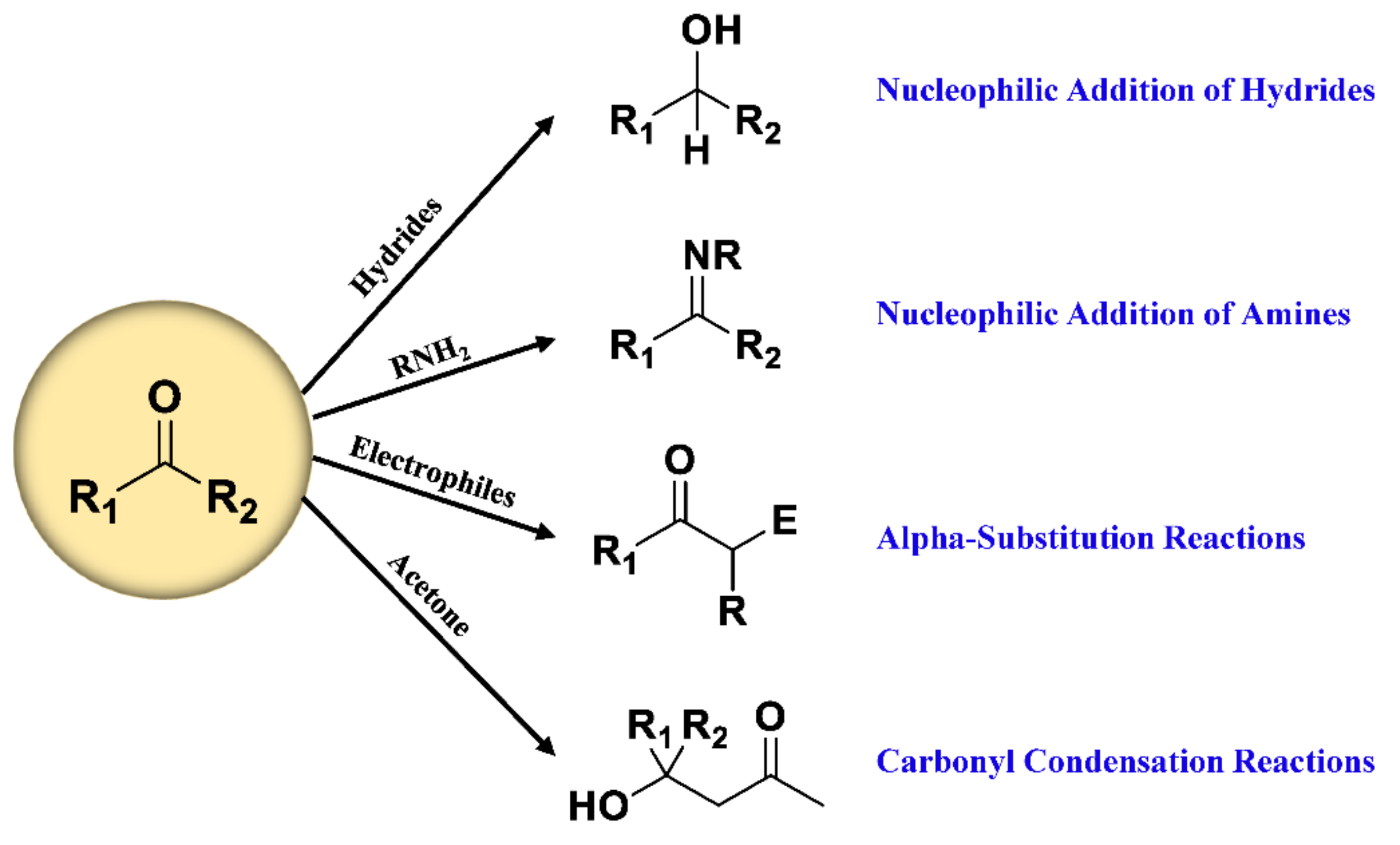

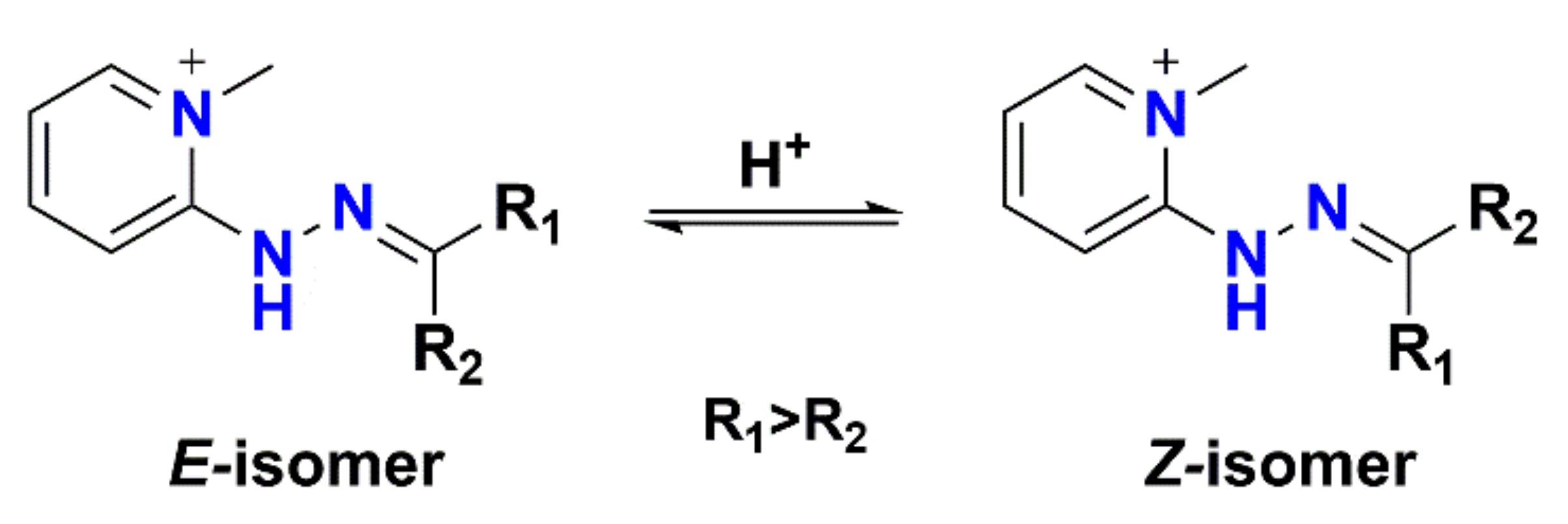
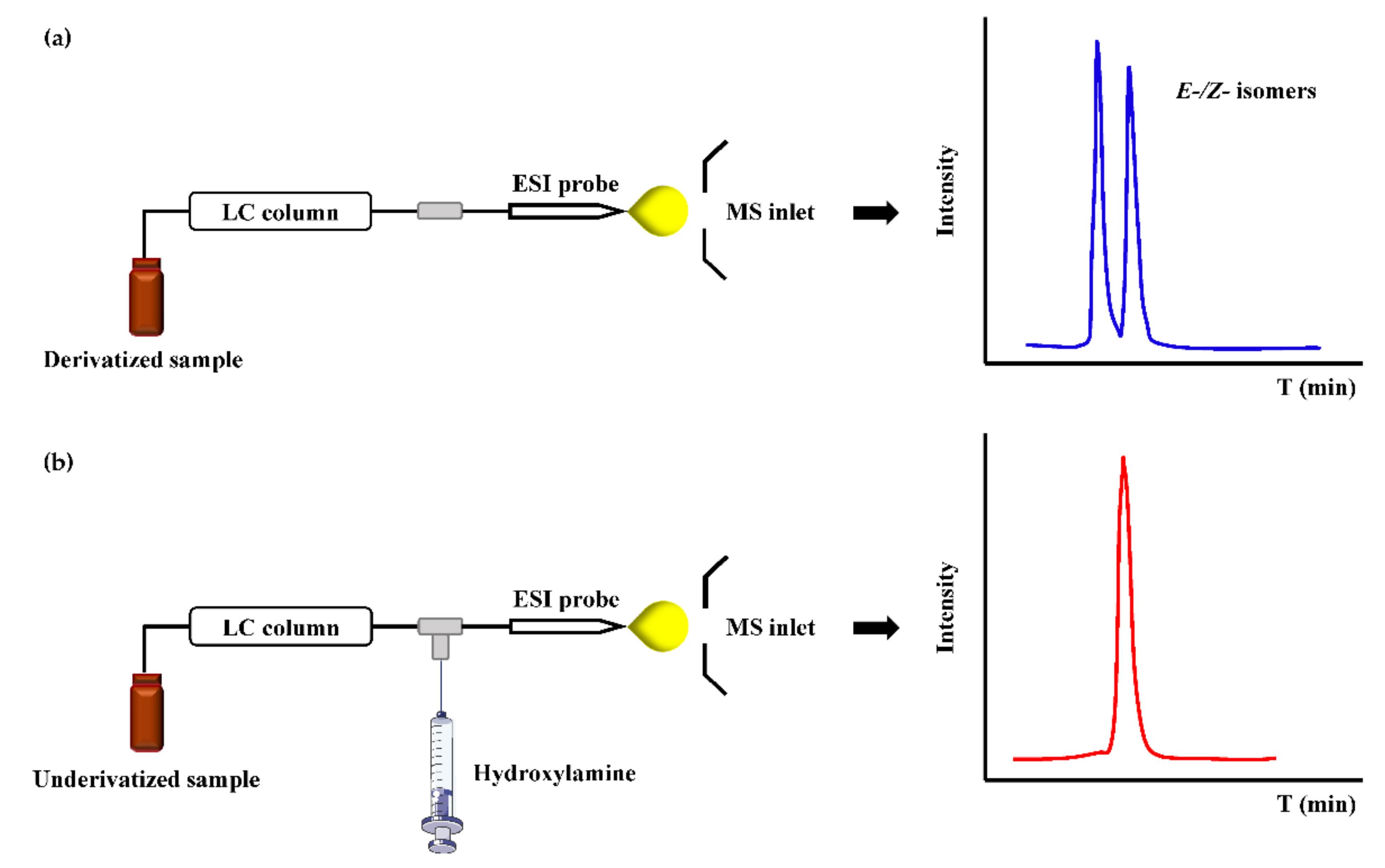
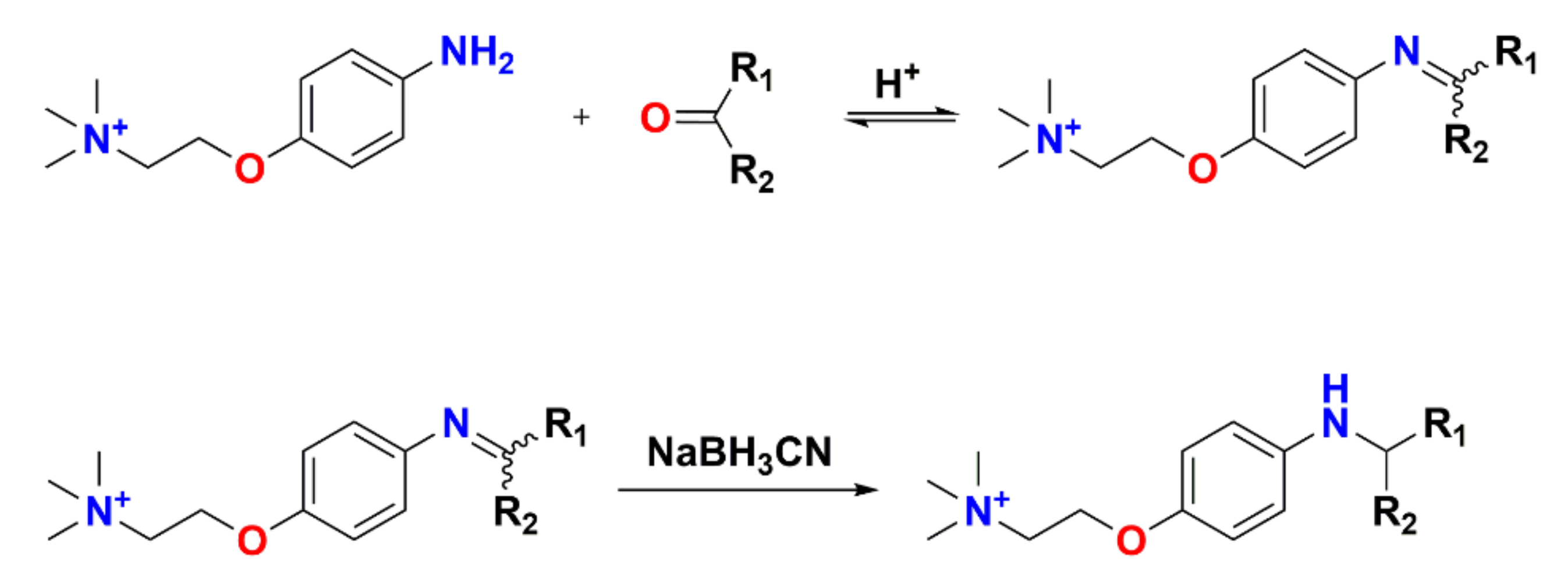
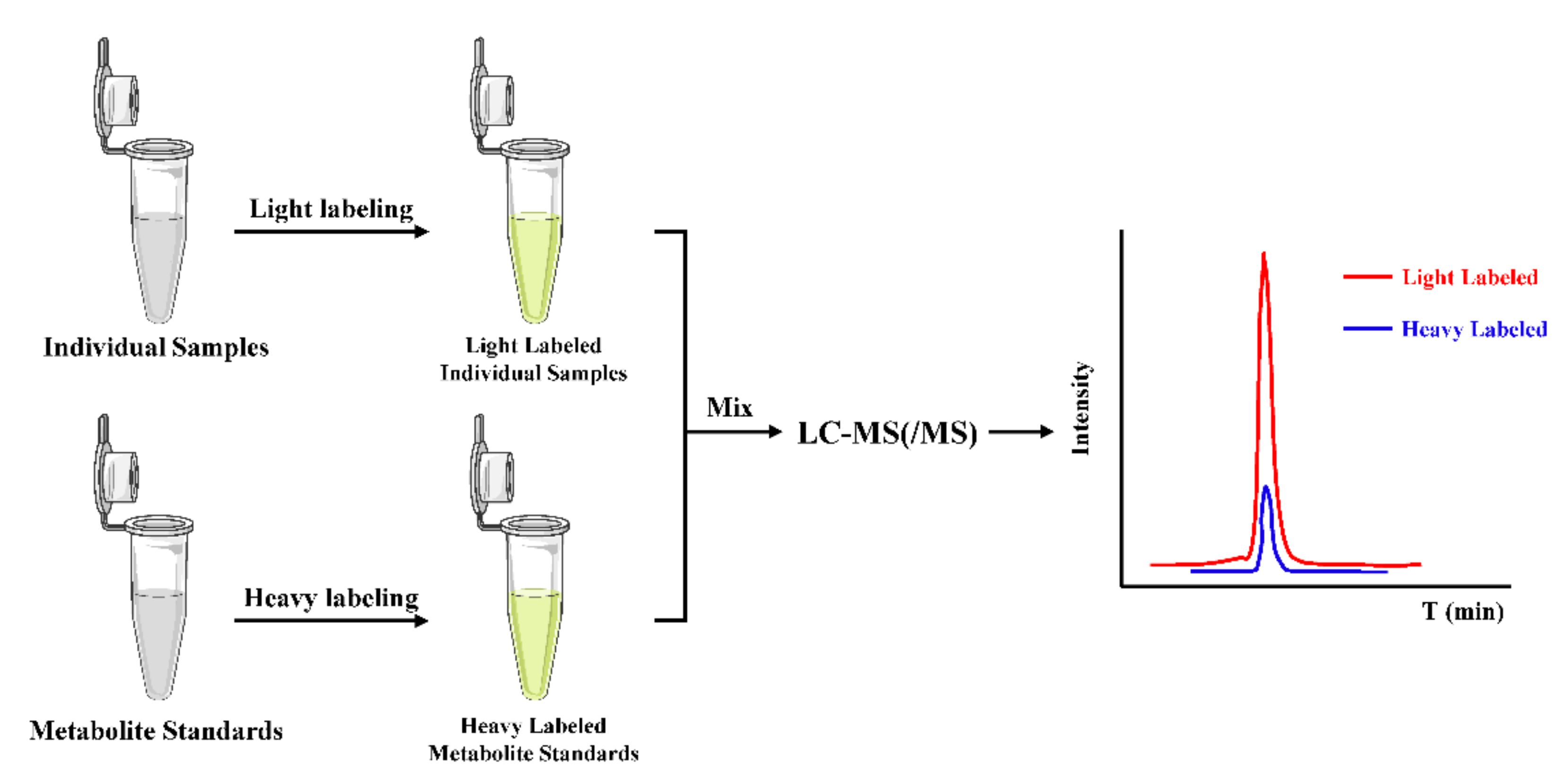
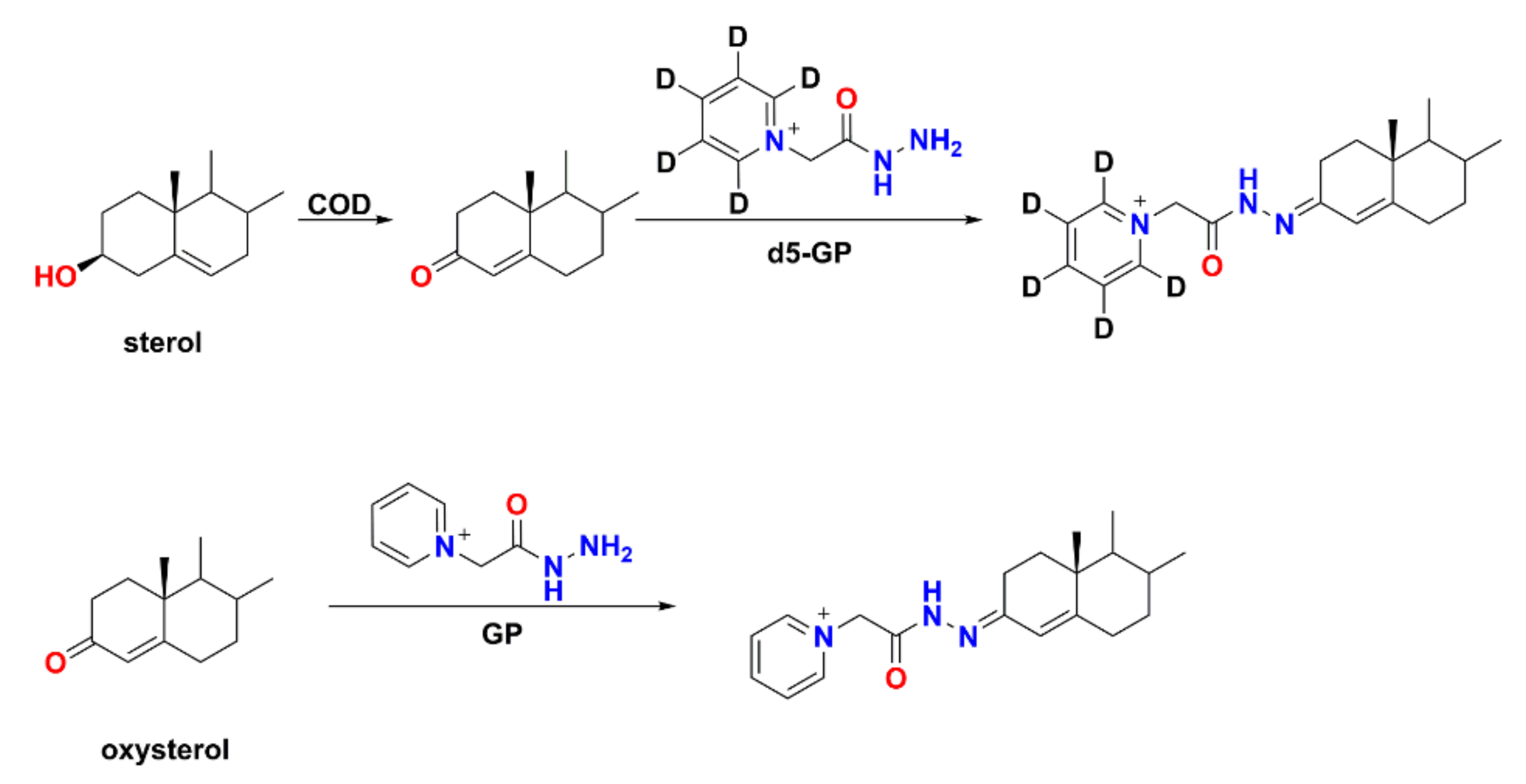

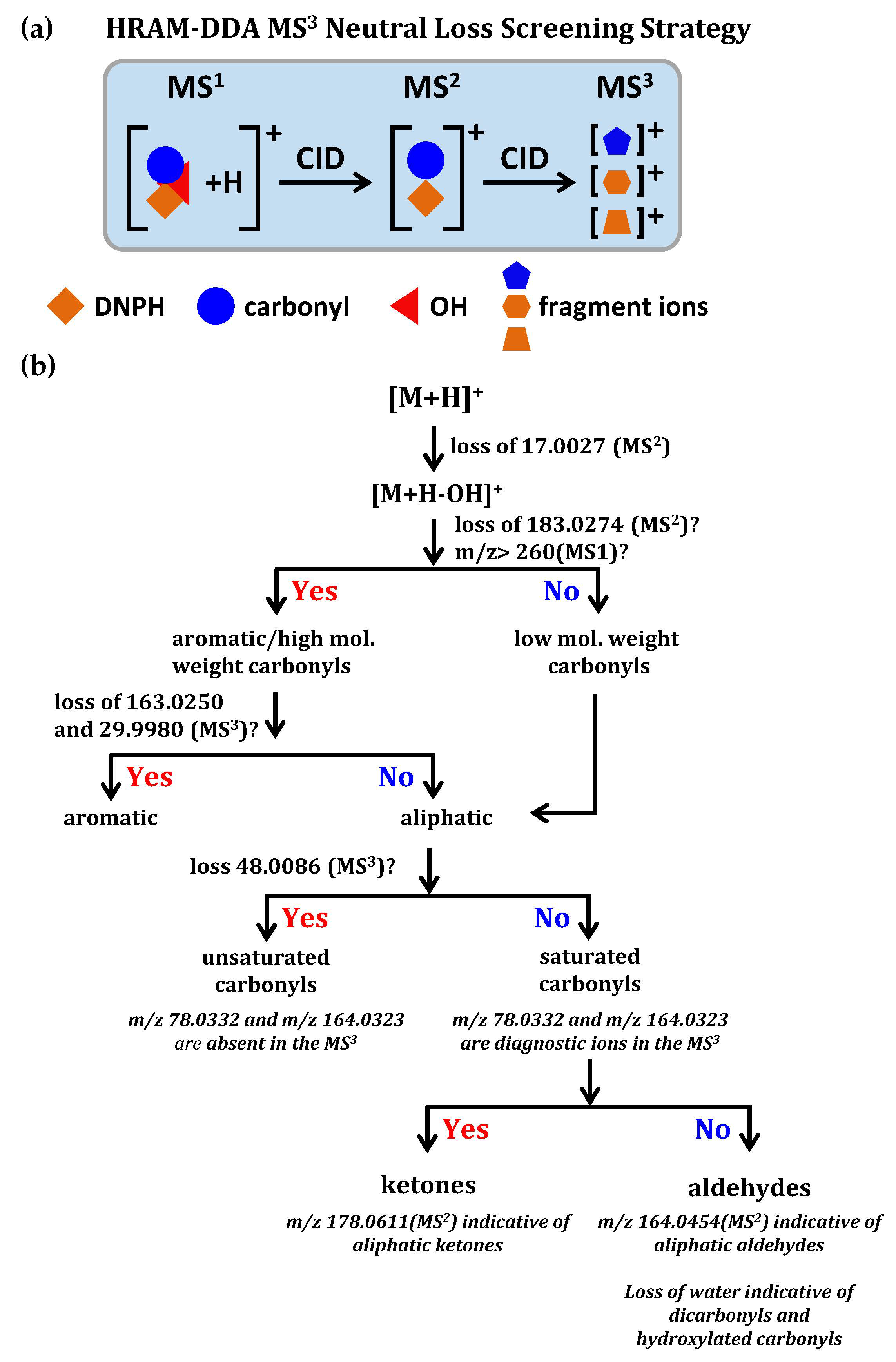
| Reagent | ICD Reagent | Analytes | Matrix | Application | Year & Ref. |
|---|---|---|---|---|---|
| HMP | d3-HMP | Brain neurosteroids | Rat brain | Differential and quantitative analysis of the changes in the brain neurosteroids levels by immobilization stress and antipsychotic drug administration | 2016 [130] |
| GP | d5-GP | Steroid hormones | Human follicular fluid | Quantitative analysis of androgenic and progestagenic steroids in polycystic ovarian syndrome patients compared with healthy controls | 2016 [131] |
| QAO | d3-QAO | Ketosterols | Human plasma and dried blood spots | Sensitive isotope dilution quantification of 7αC4 and 7α12αC4 between CTX and unaffected samples | 2014 [132] |
| MOA | d3-MOA | Ketosteroids hormones | Meat | Sensitive and accurate quantification of ketosteroids hormones in meat using MRM scan mode | 2015 [92] |
| 3-NPH | 13C6-3-NPH | MDA | Human plasma | Quantification of MDA in major depressive disorder patients | 2016 [133] |
| MPIA | d3-MPIA | Aliphatic aldehydes | Aquatic products | Quantification of aliphatic aldehydes in aquatic products | 2014 [112] |
| Ammonium acetate and PQ | 15N-ammonium acetate and PQ | HNE & HHE | Human serum | Simultaneous determination of HNE and HHE in the serum of healthy controls and pathological conditions | 2018 [134] |
| Acetylacetone | d8-acetylacetone | Formaldehyde | Personal-care products | Accurate quantification of formaldehyde in children’s personal-care products | 2017 [121] |
| Pyridine | d5-pyridine | Fatty aldehydes | Human thyroid carcinoma and para-carcinoma tissue | Identification and quantification of free fatty aldehydes in the human thyroid tissue | 2016 [127] |
| Aniline | 13C6-aniline | Carbonyl-containing metabolites | Cell-free protein synthesis | Absolute quantification of cell-free protein synthesis metabolism | 2019 [104] |
| Dns-Hz | 13C2-Dns-Hz | Carbonyl submetabolome | Human urine | Profiling the carbonyl submetabolome in human urine | 2017 [36] |
| QDA | 13CD3-QDA | Carbonyl metabolites | Tissue and cells extraction | Profiling and quantification of carbonyl metabolites | 2012 [95] |
| T3 | D3 | Fatty aldehydes | Rat plasma and brain tissue | Discovery and comprehensive characterization of endogenous fatty aldehydes in rat plasma and brain tissue | 2016 [69] |
| 4-APC | d4-4-APC | Aldehydes | Human urine and white wine | Identification of potential aldehyde-containing compounds in human urine and white wine | 2015 [110] |
| HIQB | d7-HIQB | Carbonyl compounds | Human serum | Profiling and quantitation of carbonyl compounds in human serum between myelogenous leukemia patients and healthy controls | 2017 [81] |
| DNPH | d3-DNPH | Carbonyl compounds | Saliva | Simultaneous identification and relative quantification of carbonyls in human biological fluids | 2017 [135] |
Publisher’s Note: MDPI stays neutral with regard to jurisdictional claims in published maps and institutional affiliations. |
© 2021 by the authors. Licensee MDPI, Basel, Switzerland. This article is an open access article distributed under the terms and conditions of the Creative Commons Attribution (CC BY) license (https://creativecommons.org/licenses/by/4.0/).
Share and Cite
Sun, Y.; Tang, H.; Wang, Y. Progress and Challenges in Quantifying Carbonyl-Metabolomic Phenomes with LC-MS/MS. Molecules 2021, 26, 6147. https://doi.org/10.3390/molecules26206147
Sun Y, Tang H, Wang Y. Progress and Challenges in Quantifying Carbonyl-Metabolomic Phenomes with LC-MS/MS. Molecules. 2021; 26(20):6147. https://doi.org/10.3390/molecules26206147
Chicago/Turabian StyleSun, Yuting, Huiru Tang, and Yulan Wang. 2021. "Progress and Challenges in Quantifying Carbonyl-Metabolomic Phenomes with LC-MS/MS" Molecules 26, no. 20: 6147. https://doi.org/10.3390/molecules26206147






